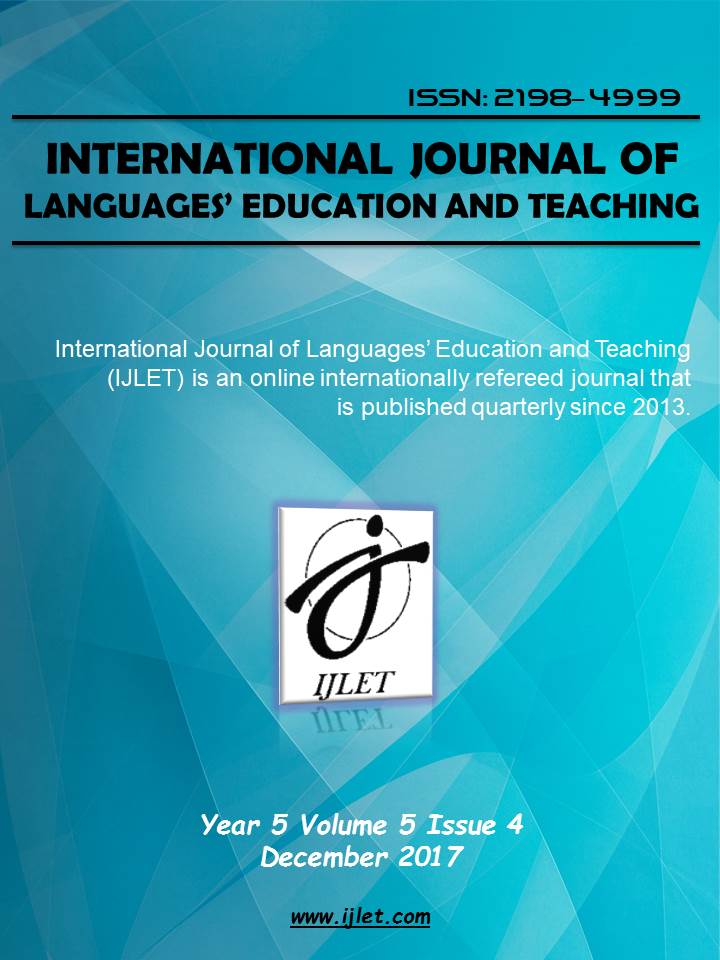Author :
Abstract
Keywords
Abstract
In this study, the resemblance of the language learning course books used in Turkey to authentic language spoken by native speakers is explored by using a corpus-based approach. For this, the 10-million-word spoken part of the British National Corpus was selected as reference corpus. After that, all language learning course books used in high schools in Turkey were scanned and transferred to SketchEngine, an online corpus query tool. Lastly, certain grammar points were extracted first from British National Corpus and then from course books; similaritites and differences were compared. At the end of the study, it was found that the language learning course books have little similarity to authentic language in terms of certain grammatical items and frequency of their collocations. In this way, the points to be revised and changed were explored. In addition, this study emphasized the role of corpus approach as a material development and analysis tool; and tested the functionality of course books for writers and for Ministry of National Education.
Keywords
- Abalı, E. (2006). Analysis Of Contextual Genuıneness Of The Dıalogues In The Coursebooks Headway, Cuttıng Edge And Opportunıtıes. M.A. Thesis, Gazi University, Ankara.
- Adams, T. (1995). What Makes Matearials Authentic? ERIC DOCUMENT 391389. Retrieved from http://www.eric.ed.gov/PDFS/ED391389.pdf
- Ağçam, R., & Bulut, A. (2016). A Corpus-based Study on Turkish Spoken Productions of Bilingual Adults.
- Bacon, S. M., & Finnemann, M. D. (1990). A study of the attitudes, motives, and strategies of university foreign-language students and their disposition to authentic oral and written input. Modern Language Journal, 74(4), 459-473.
- Barbieri, F., & Eckhardt, S. E. B. (2007). Applying corpus-based findings to form-focused instruction: The case of reported speech. Language Teaching Research, 11(3), 319-346. doi: 10.1177/1362168807077563
- Benson, P., & Voller, P. (1997). Autonomy and independence in language learning. Harlow: Longman.
- Biber, D., & Reppen, R. (2002). What does frequency have to do with grammar teaching? Studies in Second Language Acquisition, 24(2), 199-208.
- Breen, M. (1985). Authenticity in the language classroom. Applied Linguistics, 6(1), 60-70.
- Brown, J., & Eskenzai, M. (2004, June). Retrieval of authentic documents for reader-specific lexical practice. Paper presented at the InSTIL/ICALL Symposium, Venice, Italy.
- Burnard, L. (2002). Where did we go wrong? A retrospective look at the British National Corpus. Language and Computers, 42(1), 51-70.
- Crewe, J. (2011). How far do ‘global’ ELT coursebooks realize key principles of Communicative Language teaching (CLT) and enable effective teaching-learning? Unpublished MA Dissertation, University of Birmingham, Birmingham.
- Cunningsworth, A. (1995). Choosing Your Coursebook. Oxford: Heinemann.
- Daloğlu, A. (2004, June). Place of culture in English language teaching in Turkey. Paper presented at the TESOL Convention, Long Beach, CA.
- Dubin, F., & Olshtain, E. (1986). Course design : Developing programs and materials for language learning. Cambridge: Cambridge University Press.
- Dülger, O. (2016). Evaluatıon of EFL coursebooks taught in Turkey based on teachers’ views. Journal of Advances in English Language Teaching, 4(1), pp-1.
- Efe, I., & Ozer, O. (2015). A corpus-based discourse analysis of the vision and mission statements of universities in Turkey. Higher Education Research & Development, 34(6), 1110-1122.
- Gabrielatos, C. (2002). Inference: Procedures and Implications for ELT. In R. P. Millrood (Ed.), Research methodology: Discourse in teaching a foreign language. (pp. 30-51). Tambov, Russia: Tambov University Press.
- Gavioli, L. (2001). The learner as researcher: Introducing corpus concordancing in the classroom. In G. Aston (Ed.), Learning with Corpora (pp. 108-137). Bologna: Athelstan.
- Gilmore, A. (2004). A comparison of textbook and authentic interactions. ELT Journal, 58(4), 363-374. doi: 10.1093/elt/58.4.363
- Gilmore, A. (2007). Authentic materials and authenticity in foreign language learning. Language Teaching Research(40 ), 97-118. doi: 10.1017/S0261444807004144
- Haycroft, J. (1998). An introduction to English language teaching. New York: Longman.
- Howatt, A. P. R. (1984). A history of English language teaching. Oxford: Oxford University Press.
- Krashen, S. D. (1989). Language acquisition and language education: extensions and applications: Prentice Hall International.
- Kilgarriff, A., Baisa, V., Bušta, J., Jakubíček, M., Kovář, V., Michelfeit, J., ... & Suchomel, V. (2014). The Sketch Engine: ten years on. Lexicography, 1(1), 7-36.
- Lee, W. Y. (1995). Authenticity revisited: Text authenticity and learner authenticity. ELT Journal, 49(4), 323-328.
- Little, D., Devitt, S., & Singleton, D. (1989). Learning foreign languages from authentic texts theory and practice.
- Litz, D. (2005). Textbook Evaluation and ELT Management: A South Korean Case Study. Asian EFL Journal.
- McGrath, I. (2006). Teacher's and Learner's Images for Coursebooks. ELT Journal, 60/2(April), 171-180. doi: 10.1093/elt/cci104
- Mishan, F. (2005). Designing authenticity into language learning materials. Bristol: Intellect.
- Morrow, K. (1977). ‘Authentic texts in ESP’, in: S.Holden, ed. English for specific purposes. London: Modern English Publications, 13-15.
- Nunan, D. (1988). The learner-centred curriculum : Astudy in second language teaching. Cambridge: Cambridge University Press.
- Porter, D., & Roberts, J. (1981). Authentic listening activities. ELT Journal, 36(1), 37-1.
- Rayson, P. (2002). Matrix: A statistical method and software tool for linguistic analysis through corpus comparison. Unpublished PhD Dissertation, Lancaster University.
- Schulz, R. A. (1991). Secondlanguage acquisition theories and teaching practice: How do they fit? The Modern Language Journal, 75(1), 17-26. doi: 10.1111/j.1540-4781.1991.tb01078.x
- Sealey, A., & Thompson, P. (2004). ‘What do you call the dull words?’ Primary school children using corpus-based approaches to learn about language. English in Education, 38(1), 80-91. doi: 10.1111/j.1754-8845.2004.tb00774.x
- Sheldon, L. (1988). Evaluating ELT textbooks and materials. ELT Journal, 42/4(October), 237-246.
- Sinclair, J. (1996). The search for units of meaning. Textus, 9, 75-106.
- Swaffar, J. K. (1985). Reading authentic texts in a foreign language: A cognitive model. The Modern Language Journal, 69(1), 15-34.
- Sweet, H. (1964). The practical study of languages. Oxford: Oxford University Press.
- Şimşek, M. R., & Dündar, E. (2017). Investigating EFL coursebook research in Turkey: Trends in graduate theses of the 2001-2013 period. Educational Sciences: Theory & Practice, 17(3).
- Tatsuki, D. (2006). What is authenticity? The Language Teacher, (16(5)), 17-21. Retrieved from http://jalt.org/pansig/2006/HTML/Tatsuki.htm website:
